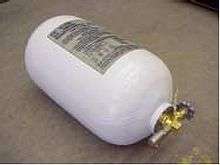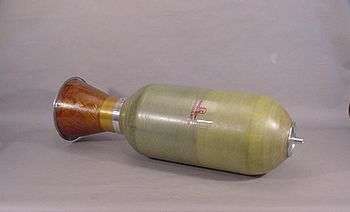Composite overwrapped pressure vessel

A composite overwrapped pressure vessel (COPV) is a vessel consisting of a thin, non-structural liner wrapped with a structural fiber composite, designed to hold a fluid under pressure. The liner provides a barrier between the fluid and the composite, preventing leaks (which can occur through matrix microcracks which do not cause structural failure) and chemical degradation of the structure. In general, a protective shell is applied for protective shielding against impact damage.[1][2] The most commonly used composites are fiber reinforced polymers (FRP),[3] using carbon and kevlar fibers. The primary advantage of a COPV as compared to a similar sized metallic pressure vessel is lower weight, but this may be offset by the increased costs of manufacturing and certification.

Testing
Various tests and inspections are performed on COPVs, including burst test, stress-rupture lifetime, and nondestructive evaluation.[4][5]
See also
- Gas cylinder
- Gas tank
- Hydrogen tank
- Graphite-Epoxy Motor
- Autofrettage, a process used in composite overwrapped pressure vessel manufacturing[6]
References
- ↑ Protective shells for composite overwrapped pressure vessels
- ↑ Metal-Lined Composite-Overwrapped Pressure Vessel
- ↑ A STRUCTURAL HEALTH MONITORING SYSTEM FOR COMPOSITE PRESSURE VESSELS
- ↑ Vessel Testing
- ↑ Stress-rupture lifetime testing
- ↑ Pat B. McLaughlan; Scott C. Forth; Lorie R. Grimes-Ledesma (March 2011). "Composite Overwrapped Pressure Vessels, A Primer" (PDF). NASA.
External links
- Composite overwrapped pressure vessels (12Nov16: error 404)